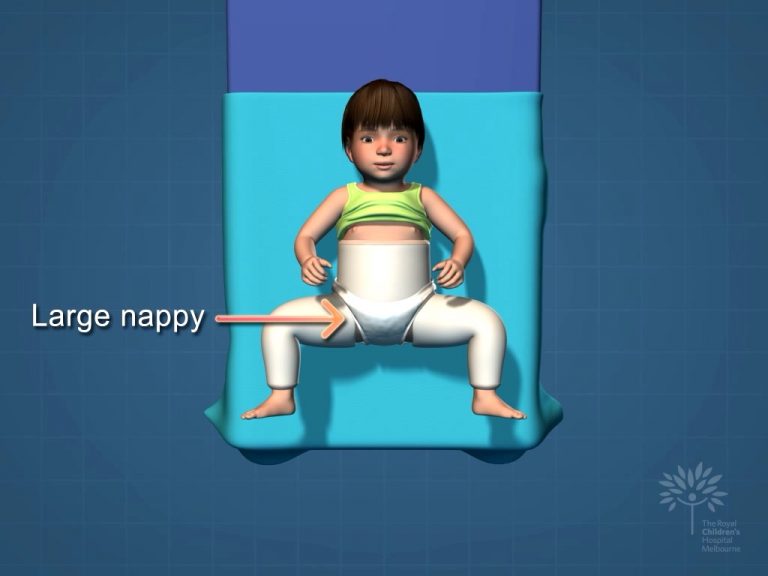What is a hip spica?
A hip spica is a plaster cast that is used to hold a child’s hip in place. It is applied by a paediatric orthopaedic surgeon in an operating theatre. The plaster cast extends from a child’s belly button to their ankles. It has an open area around the groin to allow for toileting.
As well as being used to manage children with hip dysplasia, a hip spice may also be used following other hip surgeries or a femoral (thigh) fracture.
How long will a hip spica stay on for?
Your child will usually be in a hip spica for a total of 12 weeks with a change of hip spica after the first 6 weeks. This hip spica change will occur in theatre. When your child no longer requires the hip spica it will be removed in theatre and a flexible brace (called a rhino brace) will be fitted. This brace can be removed for bathing.
Preparing for bringing your child home in a hip spica?
It is usual that your child’s car seat will require modification for them to safely travel in the car, including travelling home from the hospital. The nursing staff will help you modify your car seat. Prior to coming to the hospital you will need to arrange a hip spica adjustable crotch buckle (crotch buckle with extended strap) for your child’s car seat. This can be borrowed from the Practice Manager at your surgeons rooms. The strap which is available is designed by Britax and is suitable for use with the following car seats: Britax Safe-n-Sound, Safe-n-Sound, Baby Love, Hipod.
Your child will not fit in a new born car capsule with a hip spica.
It is illegal for a child to travel unrestrained in a car.
You are required to carry documentation with you in the car that your child is travelling in that has been signed by your orthopaedic surgeon . This documentation outlines why your child requires a modification to their car seat. It will be provided to you by the nursing staff when you are at the hospital.
It is useful to bring a few cloth nappies/baby rugs to the hospital. These will be used to position your child within their car seat.
Other equipment
It is also useful to arrange to have a bean bag at home prior to your child coming home from the hospital (see below- how to positioning my child). This is ideal to sit your child in and can easily be moved from room to room at home.
Caring for your child in a hip spica
The nursing staff in the hospital will teach you how to look after your child in a hip spica including bathing and toileting during your stay in the hospital.
Bathing
It is important that the hip spica stays dry. While the hip spica is in place your child will not be able to have a bath or shower and will need to be sponge bathed instead.
Toileting
Your child will need to wear two nappies while in a hip spica. The first nappy (which is your child’s usual size) slips in under the hip spica. A second larger sized nappy sits over the first nappy and is done up over the top of the hip spica. This technique keeps the first nappy in place and prevents the hip spica from getting soiled. Regular nappy changes will help to keep the hip spica clean and dry.

Clothing
You can dress your child with a t-shirt/jumper and socks pulled up over the hip spica. Special clothes are not required for a baby in a hip spica.
Positioning
It is difficult for a child to move by themselves within a hip spica and you will need to change your child’s position for them. This is important to prevent pressure areas within the hip spica.
Your child can rest in a variety of positions such as on their back, in semi side lying (supported by pillows), on their tummy (with supervision) and sitting up supported by a bean bag.
Purchasing or borrowing a beanbag before your child comes home with a hip spica is ideal.
Skin care
It is important to check your child’s skin where it is in contact with the edges of the hip spica each day. Check for redness, blisters, skin irritation or pressure areas. If you see pressure areas or blisters you should let your doctor know.
Lifting and carrying your child
It is most comfortable for your child to support the weight of the hip spica as you lift your child. You should avoid lifting your child under the arms without the supporting the weight of the hip spica.
To look after yourself when lifting your child with a hip spica you should lift, hold and carry your child as close as possible to your body to reduced strain on your back.
Feeding
If you are breastfeeding your child, you may need to experiment with with different positions to find a position that works for you and your child. It may be useful to use pillows to support your baby.
